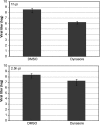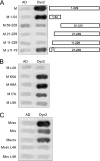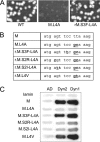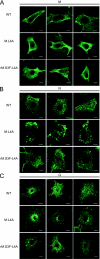The matrix protein of vesicular stomatitis virus binds dynamin for efficient viral assembly
- PMID: 20943988
- PMCID: PMC3004305
- DOI: 10.1128/JVI.01400-10
The matrix protein of vesicular stomatitis virus binds dynamin for efficient viral assembly
Abstract
Matrix proteins (M) direct the process of assembly and budding of viruses belonging to the Mononegavirales order. Using the two-hybrid system, the amino-terminal part of vesicular stomatitis virus (VSV) M was shown to interact with dynamin pleckstrin homology domain. This interaction was confirmed by coimmunoprecipitation of both proteins in cells transfected by a plasmid encoding a c-myc-tagged dynamin and infected by VSV. A role for dynamin in the viral cycle (in addition to its role in virion endocytosis) was suggested by the fact that a late stage of the viral cycle was sensitive to dynasore. By alanine scanning, we identified a single mutation of M protein that abolished this interaction and reduced virus yield. The adaptation of mutant virus (M.L4A) occurred rapidly, allowing the isolation of revertants, among which the M protein, despite having an amino acid sequence distinct from that of the wild type, recovered a significant level of interaction with dynamin. This proved that the mutant phenotype was due to the loss of interaction between M and dynamin. The infectious cycle of the mutant virus M.L4A was blocked at a late stage, resulting in a quasi-absence of bullet-shaped viruses in the process of budding at the cell membrane. This was associated with an accumulation of nucleocapsids at the periphery of the cell and a different pattern of VSV glycoprotein localization. Finally, we showed that M-dynamin interaction affects clathrin-dependent endocytosis. Our study suggests that hijacking the endocytic pathway might be an important feature for enveloped virus assembly and budding at the plasma membrane.
Figures








Similar articles
-
Characterization of the Interaction between the Matrix Protein of Vesicular Stomatitis Virus and the Immunoproteasome Subunit LMP2.J Virol. 2015 Nov;89(21):11019-29. doi: 10.1128/JVI.01753-15. Epub 2015 Aug 26. J Virol. 2015. PMID: 26311888 Free PMC article.
-
Phenotypes of vesicular stomatitis virus mutants with mutations in the PSAP motif of the matrix protein.J Gen Virol. 2012 Apr;93(Pt 4):857-865. doi: 10.1099/vir.0.039800-0. Epub 2011 Dec 21. J Gen Virol. 2012. PMID: 22190013
-
Tracking the Fate of Genetically Distinct Vesicular Stomatitis Virus Matrix Proteins Highlights the Role for Late Domains in Assembly.J Virol. 2015 Dec;89(23):11750-60. doi: 10.1128/JVI.01371-15. Epub 2015 Sep 2. J Virol. 2015. PMID: 26339059 Free PMC article.
-
[Envelope virus assembly and budding].Uirusu. 2010 Jun;60(1):105-13. doi: 10.2222/jsv.60.105. Uirusu. 2010. PMID: 20848870 Review. Japanese.
-
The role of EHD proteins at the neuronal synapse.Sci Signal. 2012 Apr 24;5(221):jc1. doi: 10.1126/scisignal.2002989. Sci Signal. 2012. PMID: 22534130 Review.
Cited by
-
Characterization of the Interaction between the Matrix Protein of Vesicular Stomatitis Virus and the Immunoproteasome Subunit LMP2.J Virol. 2015 Nov;89(21):11019-29. doi: 10.1128/JVI.01753-15. Epub 2015 Aug 26. J Virol. 2015. PMID: 26311888 Free PMC article.
-
MxA Mediates SUMO-Induced Resistance to Vesicular Stomatitis Virus.J Virol. 2016 Jun 24;90(14):6598-6610. doi: 10.1128/JVI.00722-16. Print 2016 Jul 15. J Virol. 2016. PMID: 27170750 Free PMC article.
-
A Point Mutation in the Human Parainfluenza Virus Type 2 Nucleoprotein Leads to Two Separate Effects on Virus Replication.J Virol. 2022 Feb 23;96(4):e0206721. doi: 10.1128/JVI.02067-21. Epub 2021 Dec 8. J Virol. 2022. PMID: 34878809 Free PMC article.
-
RNA splicing in a new rhabdovirus from Culex mosquitoes.J Virol. 2011 Jul;85(13):6185-96. doi: 10.1128/JVI.00040-11. Epub 2011 Apr 20. J Virol. 2011. PMID: 21507977 Free PMC article.
-
Components and Architecture of the Rhabdovirus Ribonucleoprotein Complex.Viruses. 2020 Aug 29;12(9):959. doi: 10.3390/v12090959. Viruses. 2020. PMID: 32872471 Free PMC article. Review.
References
-
- Bourhis, J. M., B. Canard, and S. Longhi. 2006. Structural disorder within the replicative complex of measles virus: functional implications. Virology 344:94-110. - PubMed
Publication types
MeSH terms
Substances
LinkOut - more resources
Full Text Sources

